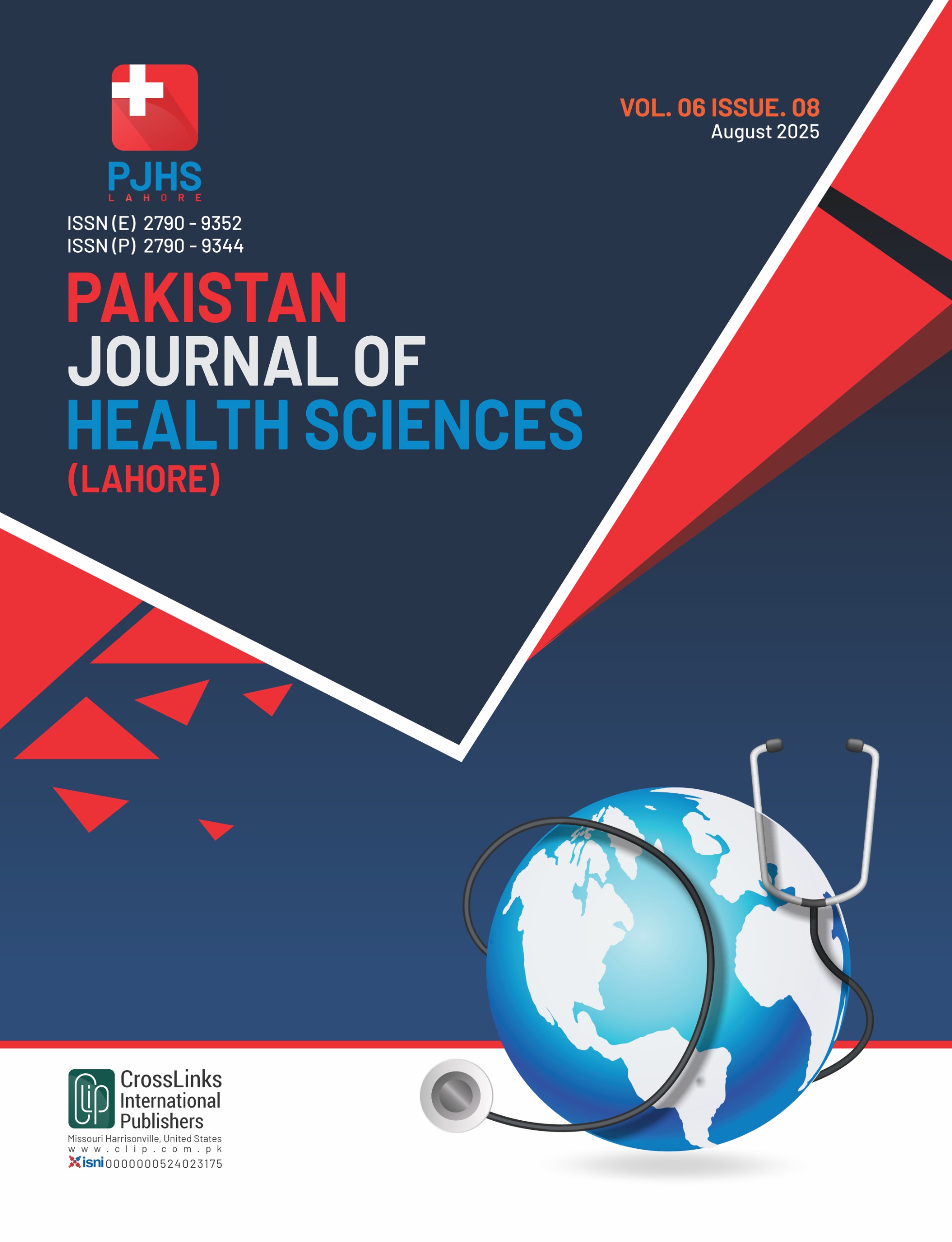Evaluation of Temporomandibular Joint Disorder in Dental Undergraduates Using the Fonseca Questionnaire
Evaluation of Temporomandibular Joint Disorder
DOI:
https://doi.org/10.54393/pjhs.v6i8.2995Keywords:
Fonseca Questionnaire, Oral Health, Pain, Temporomandibular DisorderAbstract
A basic component of general well-being and health is oral health. One common problem influencing populations worldwide is temporomandibular dysfunction (TMD). Objectives: To determine the occurrence of temporomandibular disorders in dental undergraduates using the Fonseca index. Methods: A cross-sectional analytical study was carried out with undergraduate dental students enrolled at Watim Medical and Dental College, Rawalpindi, Pakistan. The sample size was determined using the WHO sample size calculator, and participants were selected through non-probability judgmental sampling. Assessment of temporomandibular disorders was performed using the validated Fonseca Anamnestic Questionnaire. Data management and statistical analysis were conducted with SPSS version 26. Results: A total of 186 participants were included, with 149 females (80.10%) and 37 males (19.90%). Using the Fonseca Clinical Index, TMD classification revealed that 104 participants had present TMD (55.90%), while 82 had absent TMD (44.10%). Severity levels ranged from no TMD (44.09%) to mild TMD (43.01%), moderate TMD (9.68%), and severe TMD (3. 23%). Gender and TMD were statistically significantly associated (p=0.004), indicating that gender may contribute to TMD occurrence, with females being more affected. Additionally, there was a correlation between gender and TMD severity (p=0.038), suggesting that severity may vary based on an individual’s gender. However, no correlation was found between age and TMD (p=0.397). Conclusions: TMD was prevalent among dental undergraduates, with a statistically significant association with gender, particularly affecting females.
References
Chaurasia A, Ishrat S, Chaudhary PK, Dhingra K, Nagar A. Temporomandibular Disorders in North Indian Population Visiting a Tertiary Care Dental Hospital. National Journal of Maxillofacial Surgery. 2020 Jan; 11(1): 106–9. doi: 10.4103/njms.NJMS_73_17. DOI: https://doi.org/10.4103/njms.NJMS_73_17
Qvintus V, Sipilä K, Le Bell Y, Suominen AL. Prevalence of Clinical Signs and Pain Symptoms of Temporomandibular Disorders and Associated Factors in Adult Finns. Acta Odontologica Scandinavica. 2020 Oct; 78(7): 515–21. doi: 10.1080/00016357.2020.1746395. DOI: https://doi.org/10.1080/00016357.2020.1746395
Iodice G, Cimino R, Vollaro S, Lobbezoo F, Michelotti A. Prevalence of Temporomandibular Disorder Pain, Jaw Noises and Oral Behaviours in an Adult Italian Population Sample. Journal of Oral Rehabilitation. 2019 Aug; 46(8): 691–8. doi: 10.1111/joor.12803. DOI: https://doi.org/10.1111/joor.12803
Kmeid E, Nacouzi M, Hallit S, Rohayem Z. Prevalence of Temporomandibular Joint Disorder in the Lebanese Population, and Its Association With Depression, Anxiety, and Stress. Head and Face Medicine. 2020 Sep; 16(1): 19. doi: 10.1186/s13005-020-00234-2. DOI: https://doi.org/10.1186/s13005-020-00234-2
Valesan LF, Da-Cas CD, Réus JC, Denardin AC, Garanhani RR, Bonotto D, Januzzi E, de Souza BD. Prevalence of Temporomandibular Joint Disorders: A Systematic Review and Meta-Analysis. Clinical Oral Investigations. 2021 Feb; 25(2): 441–53. doi: 10.1007/s00784-020-03710-w. DOI: https://doi.org/10.1007/s00784-020-03710-w
Ângelo DF, Mota B, João RS, Sanz D, Cardoso HJ. Prevalence of Clinical Signs and Symptoms of Temporomandibular Joint Disorders Registered in the EUROTMJ Database: A Prospective Study in a Portuguese Center. Journal of Clinical Medicine. 2023 May; 12(10): 3553. doi: 10.3390/jcm12103553. DOI: https://doi.org/10.3390/jcm12103553
Zieliński G, Pająk-Zielińska B, Ginszt M. A Meta-Analysis of the Global Prevalence of Temporomandibular Disorders. Journal of Clinical Medicine. 2024 Feb; 13(5): 1365. doi: 10.3390/jcm13051365. DOI: https://doi.org/10.3390/jcm13051365
Yekkalam N, Novo M, Tyrberg MJ, Sipilä K. Risk Factors Associated With Symptoms of Temporomandibular Disorders Among Women With Hypermobile Ehlers-Danlos Syndrome: Questionnaire-Based Study in Finland and Sweden. Journal of Oral Rehabilitation. 2024 Aug; 51(8): 1390–400. doi: 10.1111/joor.13706. DOI: https://doi.org/10.1111/joor.13706
Shivamurthy PG, Kumari N, Sadaf A, Meghana MB, Azhar H, Sabrish S. Use of Fonseca's Questionnaire to Assess the Prevalence and Severity of Temporomandibular Disorders Among University Students – A Cross-Sectional Study. Dentistry. 2022 Feb; 3000(1): a001. doi: 10.5195/d3000.2022.178. DOI: https://doi.org/10.5195/d3000.2022.178
Khan MW, Zaigham AM. Prevalence and Severity of Temporomandibular Disorders in Medical/Dental Undergraduate Students. Journal of the Pakistan Dental Association. 2021 Apr; 30(2). doi: 10.25301/JPDA.302.94. DOI: https://doi.org/10.25301/JPDA.302.94
Sánchez-Torrelo CM, Zagalaz-Anula N, Alonso-Royo R, Ibáñez-Vera AJ, López Collantes J, Rodríguez-Almagro D, Obrero-Gaitán E, Lomas-Vega R. Transcultural Adaptation and Validation of the Fonseca Anamnestic Index in a Spanish Population With Temporomandibular Disorders. Journal of Clinical Medicine. 2020 Oct; 9(10): 3230. doi: 10.3390/jcm9103230. DOI: https://doi.org/10.3390/jcm9103230
Nazir MA, Izhar F, Hassan S, Tanvir M, Nemat F, Ashraf MW, Alamri A. Temporomandibular Disorders Among Dental Students in Pakistan: Assessment of Prevalence, Severity, and Associated Factors Based on Questionnaire. Scientifica. 2023; 2023(1): 8895544. doi: 10.1155/2023/8895544. DOI: https://doi.org/10.1155/2023/8895544
Alfawzan AA. An Assessment of the Prevalence and Severity of Temporomandibular Disorders Among Undergraduate Dental Students at Qassim University. World Journal of Dentistry. 2020 Sep; 11(2): 134–8. doi: 10.5005/jp-journals-10015-1715. DOI: https://doi.org/10.5005/jp-journals-10015-1715
Alharbi AA, Shukr BS, Algethami MA, Alhumaidi FY, Mohaymidan NM, Alharbi A, Algethami M, Alhumaidi FA. The Prevalence of Temporomandibular Disorders Among Dental and Medical Students in Taif, Saudi Arabia: A Cross-Sectional Study. Cureus. 2024 Jul; 16(7). doi: 10.7759/cureus.65827. DOI: https://doi.org/10.7759/cureus.65827
Lövgren A, Österlund C, Ilgunas A, Lampa E, Hellström F. A High Prevalence of TMD is Related to Somatic Awareness and Pain Intensity Among Healthy Dental Students. Acta Odontologica Scandinavica. 2018 Aug; 76(6): 387–93. doi: 10.1080/00016357.2018.1440322. DOI: https://doi.org/10.1080/00016357.2018.1440322
Xiong X, Xiao C, Zhou X, Li X, Wang J, Yi Y. Knowledge and Attitudes Regarding Temporomandibular Disorders Among Postgraduate Dental Students and Practicing Dentists in Western China: A Questionnaire-Based Observational Investigation. Pain Research and Management. 2023; 2023(1): 7886248. doi: 10.1155/2023/7886248. DOI: https://doi.org/10.1155/2023/7886248
Ram H, Shah D. Prevalence of Sign and Symptoms of TMD Among the Patients Attending Siddhpur Dental College and Hospital of Gujarat. International Journal of Applied Dental Sciences. 2020; 6: 671–5. doi: 10.22271/oral.2020.v6.i3j.1023. DOI: https://doi.org/10.22271/oral.2020.v6.i3j.1023
de Melo Rocha CO, Peixoto RF, de Resende CM, de Medeiros Alves AC, da Costa Oliveira ÂG, Seabra Barbosa GA. Psychosocial Aspects and Temporomandibular Disorders in Dental Students. Quintessence International. 2017 Mar; 48(3).
Lugassy D, Ben-Izhack G, Zissu S, Shitrit Lahav R, Rosner O, Elzami R, Shely A, Naishlos S. Anxiety, Stress, and Depression Levels Among Dental Students: Gender, Age, and Stage of Dental Education Related. Psychology, Health and Medicine. 2025 Apr; 1–5. doi: 10.1080/13548506.2025.2476085. DOI: https://doi.org/10.1080/13548506.2025.2476085
Ramachandran S, Soheilipour S, Ford NL, Brondani MA. Exploring Stressors and Coping Strategies Among Dental Students During COVID-19 Pandemic in British Columbia. Journal of Dental Education. 2023 Oct; 87(10): 1427–36. doi: 10.1002/jdd.13312. DOI: https://doi.org/10.1002/jdd.13312
Jedynak B, Jaworska-Zaremba M, Grzechocińska B, Chmurska M, Janicka J, Kostrzewa-Janicka J, et al. TMD in Females With Menstrual Disorders. International Journal of Environmental Research and Public Health. 2021 Jul; 18(14): 7263. doi: 10.3390/ijerph18147263. DOI: https://doi.org/10.3390/ijerph18147263
Downloads
Published
How to Cite
Issue
Section
License
Copyright (c) 2025 Pakistan Journal of Health Sciences

This work is licensed under a Creative Commons Attribution 4.0 International License.
This is an open-access journal and all the published articles / items are distributed under the terms of the Creative Commons Attribution License, which permits unrestricted use, distribution, and reproduction in any medium, provided the original author and source are credited. For comments













